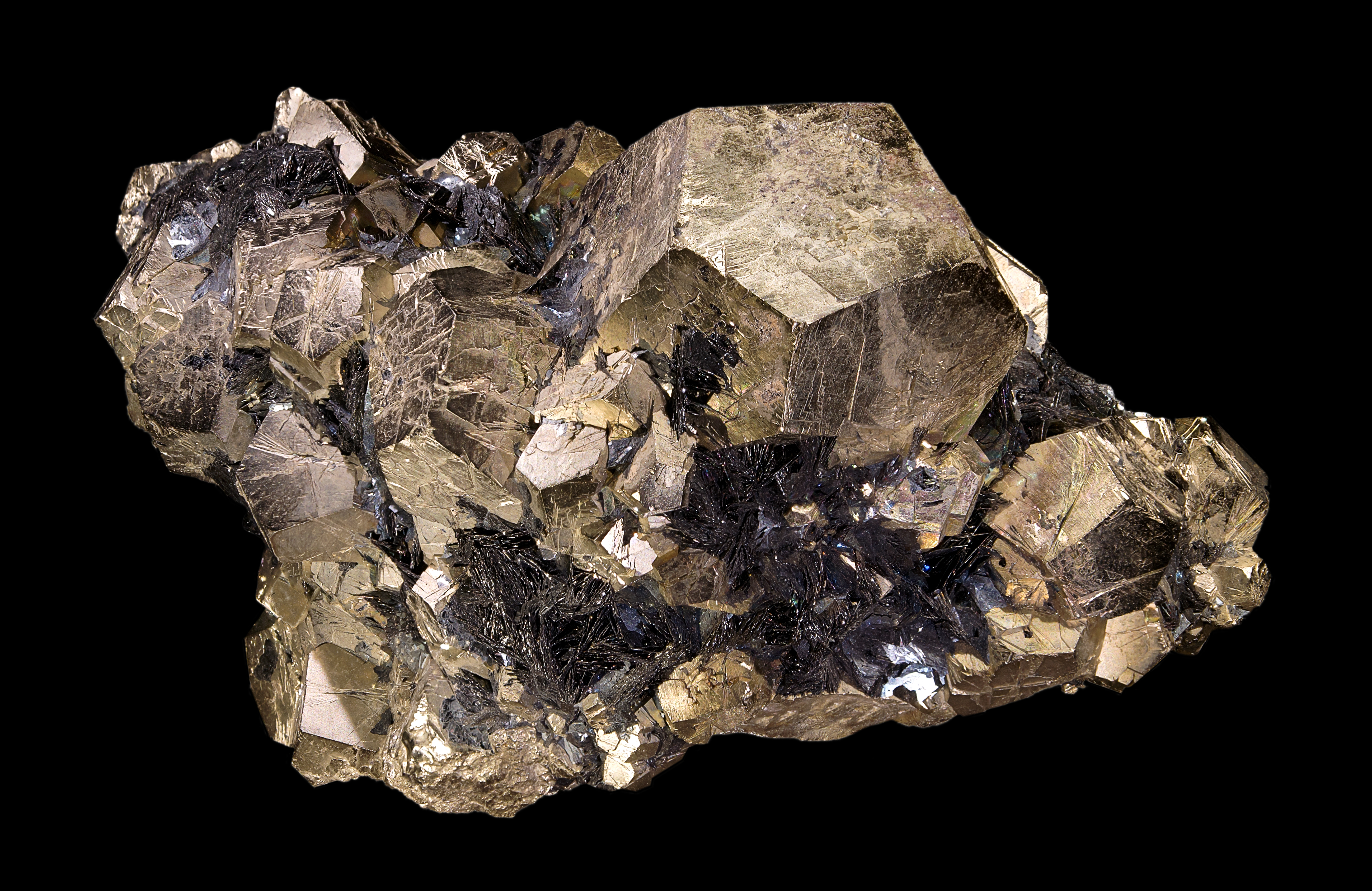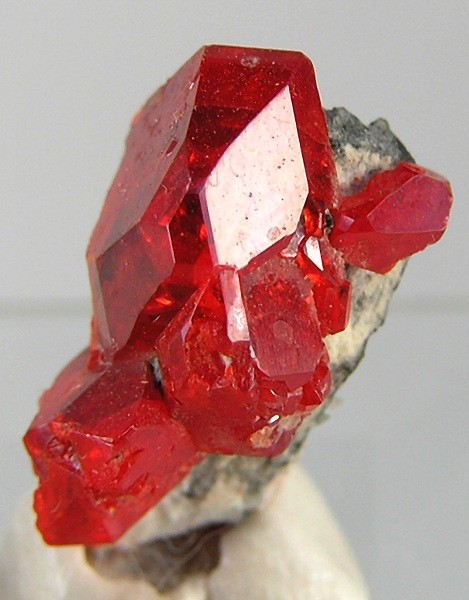|
Fletcherite
Fletcherite is a rare thiospinel sulfide mineral with formula . It is an opaque metallic steel gray mineral which crystallizes in the cubic crystal system. It is a member of the linnaeite group. It was first described in 1977 for an occurrence in the Fletcher Mine, Viburnum Trend (New Lead Belt), near Centerville, Reynolds County, Missouri. It occurs as a dissemination within copper sulfide minerals in mineralization replacing dolomite at the type locality in the Fletcher mine where it is associated with vaesite, pyrite, covellite, chalcopyrite, bornite and digenite. In an occurrence in Kalgoorlie, Australia it is found in black slate associated with pyrrhotite Pyrrhotite is an iron sulfide mineral with the formula Fe(1-x)S (x = 0 to 0.2). It is a nonstoichiometric variant of FeS, the mineral known as troilite. Pyrrhotite is also called magnetic pyrite, because the color is similar to pyrite and it .... References Sulfide minerals Cubic minerals Minerals in spa ... [...More Info...] [...Related Items...] OR: [Wikipedia] [Google] [Baidu] |
Sulfide Mineral
The sulfide minerals are a class of minerals containing sulfide (S2−) or disulfide (S22−) as the major anion. Some sulfide minerals are economically important as metal ores. The sulfide class also includes the selenides, the tellurides, the arsenides, the antimonides, the bismuthinides, the sulfarsenides and the sulfosalts.http://www.minerals.net/mineral/sort-met.hod/group/sulfgrp.htm Minerals.net Dana Classification, SulfidesKlein, Cornelis and Cornelius S. Hurlbut, Jr., 1986, ''Manual of Mineralogy'', Wiley, 20th ed., pp 269-293 Sulfide minerals are inorganic compounds. Minerals Common or important examples include: * Acanthite * Chalcocite * Bornite * Galena *Sphalerite * Chalcopyrite * Pyrrhotite * Millerite * Pentlandite * Covellite *Cinnabar * Realgar * Orpiment * Stibnite * Pyrite * Marcasite * Molybdenite Sulfarsenides: * Cobaltite * Arsenopyrite * Gersdorffite Sulfosalts: * Pyrargyrite * Proustite * Tetrahedrite * Tennantite * ... [...More Info...] [...Related Items...] OR: [Wikipedia] [Google] [Baidu] |
Sulfide Minerals
The sulfide minerals are a class of minerals containing sulfide (S2−) or disulfide (S22−) as the major anion. Some sulfide minerals are economically important as metal ores. The sulfide class also includes the selenides, the tellurides, the arsenides, the antimonides, the bismuthinides, the sulfarsenides and the sulfosalts.http://www.minerals.net/mineral/sort-met.hod/group/sulfgrp.htm Minerals.net Dana Classification, SulfidesKlein, Cornelis and Cornelius S. Hurlbut, Jr., 1986, ''Manual of Mineralogy'', Wiley, 20th ed., pp 269-293 Sulfide minerals are inorganic compounds. Minerals Common or important examples include: * Acanthite * Chalcocite * Bornite *Galena *Sphalerite *Chalcopyrite *Pyrrhotite * Millerite *Pentlandite * Covellite *Cinnabar * Realgar *Orpiment * Stibnite *Pyrite *Marcasite * Molybdenite Sulfarsenides: * Cobaltite *Arsenopyrite * Gersdorffite Sulfosalts: * Pyrargyrite *Proustite *Tetrahedrite * Tennantite * Enargite * ... [...More Info...] [...Related Items...] OR: [Wikipedia] [Google] [Baidu] |
Sulfide Mineral
The sulfide minerals are a class of minerals containing sulfide (S2−) or disulfide (S22−) as the major anion. Some sulfide minerals are economically important as metal ores. The sulfide class also includes the selenides, the tellurides, the arsenides, the antimonides, the bismuthinides, the sulfarsenides and the sulfosalts.http://www.minerals.net/mineral/sort-met.hod/group/sulfgrp.htm Minerals.net Dana Classification, SulfidesKlein, Cornelis and Cornelius S. Hurlbut, Jr., 1986, ''Manual of Mineralogy'', Wiley, 20th ed., pp 269-293 Sulfide minerals are inorganic compounds. Minerals Common or important examples include: * Acanthite * Chalcocite * Bornite * Galena *Sphalerite * Chalcopyrite * Pyrrhotite * Millerite * Pentlandite * Covellite *Cinnabar * Realgar * Orpiment * Stibnite * Pyrite * Marcasite * Molybdenite Sulfarsenides: * Cobaltite * Arsenopyrite * Gersdorffite Sulfosalts: * Pyrargyrite * Proustite * Tetrahedrite * Tennantite * ... [...More Info...] [...Related Items...] OR: [Wikipedia] [Google] [Baidu] |
Thiospinel
The thiospinel group is a group of sulfide minerals with a general formula where A is nominally a +2 metal, B is a +3 metal and X is -2 sulfide or similar anion (selenide or telluride). ''Thio'' refers to sulfur and ''spinel'' indicates their isometric spinel-like structure. As the chalcogens S, Se and Te are less electronegative than oxygen, the bonding in these materials is generally more covalent than in the oxospinels. Some are (magnetic) semiconductors but others display, at times complicated, metallic behavior, often coupled with equally complicated magnetic properties. The assignment of oxidation states is also not always as straightforward as in the more ionic oxocompounds, as is shown in the case of carrollite. Group members include: * Cadmoindite – * Carrollite – * Fletcherite Fletcherite is a rare thiospinel sulfide mineral with formula . It is an opaque metallic steel gray mineral which crystallizes in the cubic crystal system. It is a member of the linnae ... [...More Info...] [...Related Items...] OR: [Wikipedia] [Google] [Baidu] |
Covellite
Covellite (also known as covelline) is a rare copper sulfide mineral with the formula CuS. This indigo blue mineral is commonly a secondary mineral in limited abundance and although it is not an important ore of copper itself, it is well known to mineral collectors. The mineral is generally found in zones of secondary enrichment ( supergene) of copper sulfide deposits. Commonly found as coatings on chalcocite, chalcopyrite, bornite, enargite, pyrite, and other sulfides, it often occurs as pseudomorphic replacements of other minerals. The first records are from Mount Vesuvius, formally named in 1832 after N. Covelli. Composition Covellite belongs to the binary copper sulfides group, which has the formula CuxSy and can have a wide-ranging copper/sulfur ratio, from 1:2 to 2:1 (Cu/S). However, this series is by no means continuous and the homogeneity range of covellite CuS is narrow. Materials rich in sulfur CuSx where x~ 1.1- 1.2 do exist, but they exhibit " superstructures", a ... [...More Info...] [...Related Items...] OR: [Wikipedia] [Google] [Baidu] |
Cubic Minerals
Cubic may refer to: Science and mathematics * Cube (algebra), "cubic" measurement * Cube, a three-dimensional solid object bounded by six square faces, facets or sides, with three meeting at each vertex ** Cubic crystal system, a crystal system where the unit cell is in the shape of a cube * Cubic function, a polynomial function of degree three * Cubic equation, a polynomial equation (reducible to ''ax''3 + ''bx''2 + ''cx'' + ''d'' = 0) * Cubic form, a homogeneous polynomial of degree 3 * Cubic graph (mathematics - graph theory), a graph where all vertices have degree 3 * Cubic plane curve (mathematics), a plane algebraic curve ''C'' defined by a cubic equation * Cubic reciprocity (mathematics - number theory), a theorem analogous to quadratic reciprocity * Cubic surface, an algebraic surface in three-dimensional space * Cubic zirconia, in geology, a mineral that is widely synthesized for use as a diamond simulacra * CUBIC, a histology method Computing * Cubic IDE, a modu ... [...More Info...] [...Related Items...] OR: [Wikipedia] [Google] [Baidu] |
Pyrrhotite
Pyrrhotite is an iron sulfide mineral with the formula Fe(1-x)S (x = 0 to 0.2). It is a nonstoichiometric variant of FeS, the mineral known as troilite. Pyrrhotite is also called magnetic pyrite, because the color is similar to pyrite and it is weakly magnetic. The magnetism decreases as the iron content increases, and troilite is non-magnetic.Vaughan, D. J.; Craig, J. R. "Mineral Chemistry of Metal Sulfides" Cambridge University Press, Cambridge: 1978. . Structure Pyrrhotite exists as a number of polytypes of hexagonal or monoclinic crystal symmetry; several polytypes often occur within the same specimen. Their structure is based on the NiAs unit cell. As such, Fe occupies an octahedral site and the sulfide centers occupy trigonal prismatic sites. Materials with the NiAs structure often are non-stoichiometric because they lack up to 1/8th fraction of the metal ions, creating vacancies. One of such structures is pyrrhotite-4C (Fe7S8). Here "4" indicates that iron vacan ... [...More Info...] [...Related Items...] OR: [Wikipedia] [Google] [Baidu] |
Slate
Slate is a fine-grained, foliated, homogeneous metamorphic rock derived from an original shale-type sedimentary rock composed of clay or volcanic ash through low-grade regional metamorphism. It is the finest grained foliated metamorphic rock. Foliation may not correspond to the original sedimentary layering, but instead is in planes perpendicular to the direction of metamorphic compression. The foliation in slate is called " slaty cleavage". It is caused by strong compression causing fine grained clay flakes to regrow in planes perpendicular to the compression. When expertly "cut" by striking parallel to the foliation, with a specialized tool in the quarry, many slates will display a property called fissility, forming smooth flat sheets of stone which have long been used for roofing, floor tiles, and other purposes. Slate is frequently grey in color, especially when seen, en masse, covering roofs. However, slate occurs in a variety of colors even from a single locality; f ... [...More Info...] [...Related Items...] OR: [Wikipedia] [Google] [Baidu] |
Australia
Australia, officially the Commonwealth of Australia, is a sovereign ''Sovereign'' is a title which can be applied to the highest leader in various categories. The word is borrowed from Old French , which is ultimately derived from the Latin , meaning 'above'. The roles of a sovereign vary from monarch, ruler or ... country comprising the mainland of the Australian continent, the island of Tasmania, and numerous smaller islands. With an area of , Australia is the largest country by area in Oceania and the world's sixth-largest country. Australia is the oldest, flattest, and driest inhabited continent, with the least fertile soils. It is a megadiverse country, and its size gives it a wide variety of landscapes and climates, with deserts in the centre, tropical Forests of Australia, rainforests in the north-east, and List of mountains in Australia, mountain ranges in the south-east. The ancestors of Aboriginal Australians began arriving from south east Asia approx ... [...More Info...] [...Related Items...] OR: [Wikipedia] [Google] [Baidu] |
Kalgoorlie
Kalgoorlie is a city in the Goldfields–Esperance region of Western Australia, located east-northeast of Perth at the end of the Great Eastern Highway. It is sometimes referred to as Kalgoorlie–Boulder, as the surrounding urban area includes the historic townsite of Boulder and the local government area is the City of Kalgoorlie–Boulder. Kalgoorlie-Boulder lies on the traditional lands of the Wangkatja group of peoples.The name "Kalgoorlie" is derived from the Wangai word ''Karlkurla'' or ''Kulgooluh'', meaning "place of the silky pears". The city was established in 1893 during the Western Australian gold rushes. It soon replaced Coolgardie as the largest settlement on the Eastern Goldfields. Kalgoorlie is the ultimate destination of the Goldfields Water Supply Scheme and the Golden Pipeline Heritage Trail. The nearby Super Pit gold mine was Australia's largest open-cut gold mine for many years. At August 2021, Kalgoorlie–Boulder had an estimated urban p ... [...More Info...] [...Related Items...] OR: [Wikipedia] [Google] [Baidu] |
Digenite
Digenite is a copper sulfide mineral with formula: Cu9S5. Digenite is a black to dark blue opaque mineral that crystallizes with a trigonal - hexagonal scalenohedral structure. In habit it is usually massive, but does often show pseudo-cubic forms. It has poor to indistinct cleavage and a brittle fracture. It has a Mohs hardness of 2.5 to 3 and a specific gravity of 5.6. It is found in copper sulfide deposits of both primary and supergene occurrences. It is typically associated with and often intergrown with chalcocite, covellite, djurleite, bornite, chalcopyrite and pyrite. The type locality is Sangerhausen, Thuringia, Germany, in copper slate deposits. Occurrence Digenite occurs in the transitional zone of supergene oxidation of primary sulfide ore deposits, at the interface between the upper and lower saprolite ore zones. It is rarely an important mineral for copper ores, as it is more usually replaced by chalcocite further up in the weathering profile, and is a mino ... [...More Info...] [...Related Items...] OR: [Wikipedia] [Google] [Baidu] |



.jpg)
.jpg)
